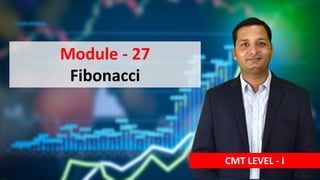
Section 3 - Chapter 16 Part II - Fibonacci & Elliot Wave
- 1. Module - 27 Fibonacci CMT LEVEL - I
- 2. What is a Fibonacci Retracement? • A Fibonacci Retracement is a term used in technical analysis that refers to areas of support or resistance. • Fibonacci Retracement levels use horizontal lines to indicate where possible support and resistance levels are. • Each level is associated with a percentage.
- 3. What is a Fibonacci Retracement? • The percentage is how much of a prior move the price has retraced. • The Fibonacci retracement levels are 23.6%, 38.2%,50.0%, 61.8% and 78.6%. • Fibonacci Use to Measure Corrective Waves to Identify Impulsive Wave
- 4. How to Calculate Fibonacci Retracement Levels • If you start a sequence of numbers with zero and one, and then keep adding the prior two numbers, you end up with a number string like this: • 0, 1, 1, 2, 3, 5, 8, 13, 21, 34, 55, 89, 144, 233, 377, 610, 987...with the string continuing on indefinitely. • The ration of 55 over 89 = 61.8% & 34 over 89 = 38.2% , this ratio is repeatedly use in same proportionate like 144 over 377 = 38.2% & 233 over 377 = 61.8% • You may wonder where these numbers come from, though. • They are based on something called the Fibonacci Golden Ratio.
- 5. How to Calculate Fibonacci Retracement Levels • Fibonacci Retracement drawn between any two significant price points, such as a high and a low, and then the indicator will create the levels between those two points. • Fibonacci Retracement Generally Measure Impulsive Waves to ascertain Corrective Wave.
- 6. Trend Estimation using Fibonacci Retracement?
- 7. Why we need Fibonacci Retracement? •The indicator connects any two points that the trader views at relevant, typically a high and low point. •Once the indicator has been drawn on the chart, the levels are fixed and will not change. The percentage levels provided are areas where the price could stall or reverse. •Levels should not be relied on exclusively. For example, it is dangerous to assume the price will reverse after hitting a specific Fibonacci level. It may, but it also may not.
- 8. Why we need Fibonacci Retracement? •Fibonacci retracement levels are most frequently used to provide potential areas of interest. If a trader wants to buy, they watch for the price to stall at a Fibonacci level and then bounce off that level before buying. •The most commonly used ratios include 23.6%, 38.2%, 50%, 61.8% and 78.6%. These represent how much of a prior move the price has corrected or retraced.
- 9. Fibonacci Extension •Fibonacci extensions are a tool that traders can use to establish profit targets or estimate how far a price may travel after a retracement/pullback is finished. • Extension levels are also possible areas where the price may reverse. •Extensions are drawn on a chart, marking price levels of possible importance
- 10. Fibonacci Extension •Common Fibonacci extension levels are 61.8%, 100%, 161.8%, 200%, and 261.8%. •The Fibonacci extensions show how far the next price wave could move following a pullback. •The Technical traders believe these common ratios may also have significance in the financial markets. •Extension levels signal possible areas of importance, but should not be relied on exclusively.
- 12. What Fibonacci Extension Tell You? •Fibonacci extensions are a way to establish price targets or find projected areas of support or resistance • when the price is moving into an area where other methods of finding support or resistance are not applicable or evident. • Fibonacci extensions are areas of possible interest. •Fibonacci extensions can be used for any timeframe or in any market.
- 13. Fibonacci Retracement V/s Extension •Fibonacci retracements measure the pullbacks (Corrective Wave) within a trend, •while Fibonacci extensions measure the impulse waves in the direction of the trend. •While Fibonacci retracements apply percentages to a pullback, • Fibonacci extensions apply percentages to a move back in the trending direction.
